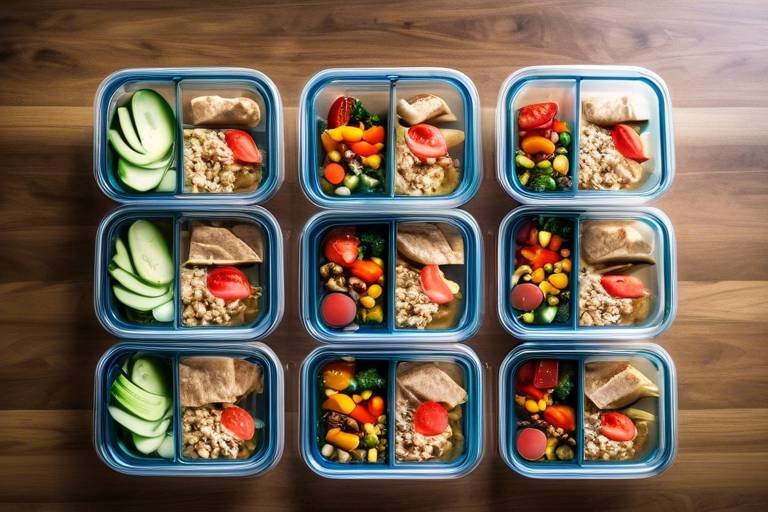Navigating a Children’s Menu: Healthy Choices at Restaurants
Dining out with kids can be a delightful experience, but it also presents a unique set of challenges, especially when it comes to making healthy food choices. As parents, we want our little ones to enjoy their meals while also ensuring they’re getting the nutrition they need for their growth and development. With that in mind, navigating a children's menu can feel like wandering through a maze of colorful options that often prioritize taste over health. But fear not! With a little knowledge and a keen eye, you can make informed decisions that lead to nutritious and delicious meals for your children.
First, let's consider the importance of understanding children's nutritional needs. Kids are not just mini-adults; they have specific dietary requirements that are crucial for their ongoing development. For instance, they need a balanced intake of carbohydrates, proteins, fats, vitamins, and minerals. So, when you glance at a children's menu, look for items that are rich in these essential nutrients. Think of it as a treasure hunt where the prize is a plate full of wholesome goodness!
As we dive deeper into the world of children's menus, it’s essential to recognize that not all options are created equal. Many restaurants offer meals that are loaded with sugars, unhealthy fats, and refined grains. This is where reading the menu becomes an art form. Familiarizing yourself with key terms can help you decipher what’s truly healthy. For instance, look for words like "grilled," "baked," or "steamed," which often indicate healthier cooking methods. On the other hand, terms like "fried" or "creamy" might be red flags that signal a dish high in unhealthy fats and calories.
Furthermore, identifying healthy ingredients is crucial. Whole grains, lean proteins, and fresh vegetables should be your best friends when selecting meals for your kids. Whole grains, like brown rice and whole wheat bread, provide essential fiber, while lean proteins, such as chicken or fish, support muscle growth. Fresh veggies not only offer vitamins but also add vibrant colors to the plate, making meals more appealing to young diners. Remember, a plate full of color is not just aesthetically pleasing; it’s a sign of a nutritious meal!
In your quest for healthy choices, understanding portion sizes is equally important. Kids don’t need adult-sized servings, and often, a smaller portion can be just right. Restaurants typically serve larger portions than necessary, so consider sharing a meal or asking for a smaller size. This not only helps prevent food waste but also teaches kids about moderation. A great rule of thumb is to visualize a plate divided into sections—half for fruits and veggies, a quarter for lean protein, and a quarter for whole grains. This simple method can guide you in making balanced choices.
Finally, let’s not forget about the dining experience itself! Encouraging kids to try new foods can be a fun adventure. Involving them in meal choices can spark their curiosity and willingness to explore different flavors. When they feel included in the decision-making process, they’re more likely to embrace new tastes. Plus, setting a positive example by enjoying a variety of foods yourself can significantly influence their eating habits. After all, kids often mimic what they see!
In conclusion, navigating a children's menu doesn’t have to be overwhelming. By understanding nutritional needs, reading menus carefully, identifying healthy ingredients, managing portion sizes, and encouraging adventurous eating, you can ensure that your kids enjoy nutritious meals while dining out. So the next time you’re at a restaurant, remember that with a little knowledge and creativity, you can turn a simple meal into a delightful and healthy experience for your children!
- What should I look for on a children's menu?
Look for meals that include whole grains, lean proteins, and plenty of vegetables. Avoid items that are fried or loaded with creamy sauces.
- How can I encourage my child to try new foods?
Involve them in the meal selection process and offer a variety of foods at home to create a positive association with trying new things.
- Are fast food restaurants a good option for healthy eating?
Yes, but it requires careful selection. Choose grilled options, healthier sides like fruit or salads, and avoid sugary drinks.

Understanding Children's Nutritional Needs
When it comes to our little ones, understanding their nutritional needs is like deciphering a secret code. Children are in a constant state of growth and development, which means they require a balanced diet rich in essential nutrients to fuel their bodies and minds. Think of it as building a house; without the right materials, the structure won’t stand strong. So, what are these crucial nutrients that our kids need?
First and foremost, proteins play a vital role in the growth and repair of tissues. They are the building blocks of the body, essential for developing muscles, skin, and even the immune system. Foods rich in protein include lean meats, fish, eggs, beans, and nuts. Next up, we have carbohydrates, which are the primary source of energy. But not all carbs are created equal! Whole grains, fruits, and vegetables provide the energy kids need while also offering fiber and other important nutrients.
Then there are fats. Yes, you heard it right! Healthy fats are essential for brain development and overall health. Sources like avocados, olive oil, and fatty fish should be included in their diet. And let’s not forget about vitamins and minerals. These are crucial for various bodily functions, from bone health to immune support. For instance, calcium is vital for strong bones, while iron is essential for blood health.
To make informed choices at restaurants, parents should look for menu items that include these essential nutrients. A well-rounded meal for children should ideally include:
- Protein: Chicken, fish, beans
- Whole Grains: Brown rice, whole grain pasta
- Fruits and Vegetables: A colorful side salad or steamed veggies
- Healthy Fats: Olive oil dressing, avocado slices
It’s important to remember that children have different energy needs based on their age, activity level, and growth spurts. For example, a toddler's portion sizes will differ significantly from those of a pre-teen. Therefore, understanding how to read children’s menus effectively can help parents make choices that align with their kids' nutritional requirements. Look for keywords like “grilled,” “baked,” or “steamed” to find healthier options, and always be on the lookout for those hidden sugars and unhealthy fats.
In conclusion, being mindful of children's nutritional needs is essential for their overall well-being. By focusing on providing a variety of nutrient-dense foods, parents can help their children grow strong and healthy while enjoying the dining experience. It’s not just about filling their bellies; it’s about nourishing their bodies and minds for the exciting adventures that lie ahead!

Reading the Menu: Key Terms to Know
When it comes to dining out with kids, navigating the menu can feel like deciphering a secret code. With so many terms and descriptions, it’s easy to get lost in a sea of culinary jargon. But don’t worry! Understanding a few key terms can empower you to make healthier choices for your little ones. It’s all about being informed and knowing what to look for. Here are some important terms to keep in mind when scanning the menu:
- Grilled: This method of cooking uses direct heat, which is generally healthier than frying. Grilled options often retain their nutrients and flavor without the extra calories from added fats.
- Baked: Similar to grilled, baked items are cooked in an oven without the need for additional oils. This is a great way to enjoy foods like chicken or fish while keeping them nutritious.
- Fresh: Always a good sign! Fresh ingredients are usually more nutritious than processed ones. Look for dishes that emphasize fresh vegetables, fruits, and meats.
- Whole Grain: If you see this term, it’s a green light! Whole grains are packed with fiber and nutrients, making them a healthier choice compared to refined grains.
- Lightly Sauced: This indicates that the dish has minimal sauce, which can help reduce calorie intake. Opting for lightly sauced dishes means your child can enjoy flavor without excessive sugar or fat.
But wait, there’s more! It’s also essential to be aware of terms that might indicate less healthy options. For example, words like fried or crispy often suggest that the dish is cooked in oil, increasing its calorie count and fat content. Similarly, terms like creamy or rich can hint at high-fat sauces that may not be the best choice for your kids.
Another crucial aspect to consider is the portion size. Many restaurants serve large portions, which can be overwhelming for children. When you see a dish that seems hefty, consider sharing it or asking for a smaller portion. It’s a great way to manage calorie intake while ensuring your child enjoys a variety of flavors.
Lastly, don’t hesitate to ask the server for clarification on menu items. They can often provide insights into how dishes are prepared and suggest healthier modifications. Knowledge is power, and being proactive about your child’s dietary choices can lead to a more enjoyable dining experience for everyone!

Identifying Healthy Ingredients
When it comes to choosing meals for our little ones, understanding healthy ingredients is key. As parents, we want to ensure that our children are not only satisfied but also nourished. So, how do we navigate through the sea of options on a children's menu? It’s all about knowing what to look for! Start by scanning for whole grains, lean proteins, and an array of fresh vegetables. These ingredients are not just buzzwords; they are the building blocks of a nutritious meal.
Whole grains are an excellent source of fiber, which is essential for digestive health. Look for items like brown rice, quinoa, or whole grain bread. For instance, if you see a sandwich option that specifies "whole grain bread," you can feel confident that you're making a better choice. On the flip side, refined grains, such as white bread or white rice, lack the nutrients and fiber that whole grains provide. It’s like choosing between a shiny, new car and an old clunker; one will get you where you need to go, but the other will do it with style and efficiency!
Next up is lean proteins, which are vital for growth and development. Look for options like grilled chicken, turkey, or fish. These proteins not only help in building muscles but also provide essential amino acids that children need. Avoid fried or heavily processed meats, as they can be high in unhealthy fats. Think of it this way: would you rather fuel your child with high-octane gasoline or cheap, low-quality fuel? The choice is clear!
Fresh vegetables are another crucial component. They are packed with vitamins, minerals, and antioxidants. When scanning the menu, aim for dishes that feature a colorful variety of veggies. A vibrant salad or a side of steamed broccoli can add a nutritional punch to any meal. If the menu offers a “vegetable medley,” it's a great opportunity to introduce your child to different flavors and textures. Plus, involving them in the selection process can make them more excited about eating their greens!
To summarize, here are the key ingredients to look for when identifying healthy options on a children's menu:
- Whole Grains: Brown rice, quinoa, whole grain bread.
- Lean Proteins: Grilled chicken, turkey, fish.
- Fresh Vegetables: Colorful salads, steamed veggies.
By being vigilant and informed, you can help your children develop healthy eating habits that will last a lifetime. Remember, the goal is to make dining out a fun and nutritious experience for your kids, ensuring they enjoy their meals while getting the nutrients they need to grow strong and healthy!
Q: How can I encourage my child to eat more vegetables?
A: Involve them in meal planning and preparation. Make it a fun activity where they can choose a new vegetable to try each week!
Q: Are fast food options ever healthy for kids?
A: Yes! Many fast food restaurants now offer healthier choices, such as salads, fruit cups, and grilled chicken. Always read the menu carefully!
Q: How can I teach my child about healthy eating?
A: Lead by example! Show them how you make healthy choices and explain the benefits of different foods in a way they can understand.

Whole Grains vs. Refined Grains
When it comes to choosing the right carbohydrates for your children, understanding the difference between whole grains and refined grains is crucial. Whole grains are the grains that retain all parts of the grain kernel—the bran, germ, and endosperm. This means they are packed with essential nutrients such as fiber, vitamins, and minerals that are vital for your child's growth and development. On the other hand, refined grains have been processed to remove the bran and germ, which strips away many of these nutrients. This can lead to a less nutritious option for your little ones.
So, why should you care about this distinction? Well, whole grains can provide your children with sustained energy, better digestion, and a lower risk of chronic diseases later in life. To illustrate this point, consider the following:
| Whole Grains | Refined Grains |
|---|---|
| Brown rice | White rice |
| Whole wheat bread | White bread |
| Oats | Instant oatmeal |
| Quinoa | White pasta |
When you’re perusing a children’s menu, look for terms like “whole grain” or “100% whole wheat”. These are indicators that the dish includes the more nutritious option. However, be wary of items that simply say “wheat” or “multigrain,” as these can often be misleading. They might still contain refined grains along with a small percentage of whole grains, which doesn’t offer the same health benefits.
Incorporating whole grains into your child's diet doesn’t have to be a chore. You can start by making small changes—like swapping out white bread for whole grain, or choosing brown rice instead of white rice. This not only improves the nutritional value of their meals but also introduces them to a variety of flavors and textures. Remember, the goal is to make these changes enjoyable and part of a balanced diet.

Lean Proteins for Growing Kids
When it comes to fueling our little ones, lean proteins are like the superheroes of nutrition. They play a crucial role in supporting growth, muscle development, and overall health. But what exactly qualifies as a lean protein? Think of options like chicken breast, turkey, fish, beans, and tofu. These foods pack a punch with essential amino acids without the extra fat that can come with other protein sources.
Choosing lean proteins for your kids is not just about keeping them healthy; it’s about giving them the energy they need to run, play, and learn. For instance, a juicy grilled chicken breast can be a fantastic centerpiece for a meal, providing the necessary nutrients without weighing them down. On the other hand, fried chicken, while delicious, can introduce unnecessary fats that don’t serve our children well.
Here’s a quick breakdown of some excellent lean protein choices:
| Protein Source | Benefits |
|---|---|
| Chicken Breast | High in protein, low in fat, great for muscle growth. |
| Turkey | Rich in vitamins and minerals, supports immune function. |
| Fish (like salmon and tuna) | Omega-3 fatty acids for brain health and development. |
| Beans (like black beans and lentils) | High in fiber, great for digestion and sustained energy. |
| Tofu | Plant-based protein, versatile and easy to incorporate into meals. |
Incorporating these proteins into your child's diet doesn’t have to be a chore. You can whip up a delicious stir-fry with chicken and colorful vegetables, or make a hearty bean chili that’s sure to please even the pickiest eaters. The key is to get creative and make mealtime fun!
Moreover, involving your kids in the cooking process can spark their interest in trying new foods. Let them help season the chicken or mix the ingredients for a bean salad. This not only teaches them valuable life skills but also gives them a sense of ownership over their meals. And who knows? They might surprise you by asking for seconds of that healthy dish you thought they would turn their noses up at!
In summary, lean proteins are essential for growing kids. By choosing healthier options, you can ensure they receive the nutrients they need while also fostering a positive relationship with food. Remember, the journey to healthy eating is a marathon, not a sprint. Every small step counts, and making informed choices today can set the stage for a lifetime of healthy habits.
1. What are some easy ways to incorporate lean proteins into my child's diet?
Start by adding grilled chicken to salads, using turkey in sandwiches, or serving fish tacos. You can also include beans in soups or as a side dish.
2. How can I encourage my child to try new lean protein sources?
Involve them in meal planning and preparation. Let them choose a new protein to try each week, and make it a fun family activity!
3. Are plant-based proteins as beneficial as animal proteins?
Yes! Plant-based proteins like beans, lentils, and tofu are excellent sources of nutrition and can be just as effective for growth and development when included as part of a balanced diet.

Portion Sizes and Serving Suggestions
When dining out with children, one of the most critical aspects to consider is portion sizes. Kids have different appetites compared to adults, and often, restaurant portions are designed for grown-ups, which can lead to overeating or wasted food. Understanding appropriate portion sizes is essential for ensuring that your child gets the right amount of nutrition without overindulging. A good rule of thumb is to aim for portions that are about the size of your child's fist. This visual cue can help both parents and children gauge what a healthy serving looks like.
It’s also important to remember that not all meals need to be consumed in one sitting. Sharing dishes can be a fantastic way to manage portion sizes while introducing kids to a variety of flavors. For instance, consider ordering a few appetizers or a couple of side dishes to share rather than one large entrée. This approach not only helps in controlling portions but also allows children to sample different foods, making the experience more enjoyable and educational.
In addition, many restaurants now offer children's meal options that come with smaller portions specifically designed for younger diners. These meals often include a main dish along with a side and a drink, making them a convenient choice for parents. However, it’s wise to check the nutritional content of these meals, as some may still be high in calories, sugars, or unhealthy fats.
Here’s a simple table to illustrate some typical portion sizes for children:
| Food Item | Recommended Portion Size |
|---|---|
| Fruits (e.g., apple, banana) | 1 medium piece or 1/2 cup sliced |
| Vegetables (e.g., carrots, broccoli) | 1/2 cup cooked or 1 cup raw |
| Grains (e.g., rice, pasta) | 1/2 cup cooked |
| Protein (e.g., chicken, fish) | 2-3 ounces |
| Dairy (e.g., milk, yogurt) | 1 cup milk or 6 ounces yogurt |
Lastly, don’t hesitate to ask the restaurant staff for recommendations on portion sizes or to customize a meal to better fit your child’s needs. Many places are more than willing to accommodate special requests, whether it's serving a smaller portion or providing extra veggies instead of fries. Remember, dining out can be a delightful experience for your children, especially when you prioritize their health and well-being.
- What should I do if my child doesn't finish their meal? It's perfectly okay! Encourage them to save leftovers for later or share with someone else.
- Are children's menu options always healthy? Not necessarily. Always check the ingredients and portion sizes to make informed choices.
- How can I encourage my child to eat healthier when dining out? Involve them in the meal selection process and model healthy eating habits yourself.

Making Healthier Choices at Fast Food Restaurants
Fast food restaurants are often seen as a convenient option for families on the go, but they can also pose significant challenges when it comes to making healthy food choices. With enticing advertisements and a plethora of options, it can be easy to fall into the trap of selecting meals that are high in calories, fats, and sugars. However, with a little knowledge and awareness, parents can navigate these menus to find healthier selections that will satisfy their children’s hunger without compromising on nutrition.
One of the first steps to making healthier choices at fast food restaurants is to understand the menu layout. Many establishments now offer a "lighter fare" section or highlight healthier options with symbols. Look for items that are baked, grilled, or steamed rather than fried. For example, a grilled chicken sandwich can be a much better choice than a crispy fried version. Additionally, many restaurants now provide calorie counts and nutritional information on their menus or websites, making it easier for parents to make informed decisions.
When it comes to sides, children often gravitate towards fries, but these can significantly increase the calorie count of a meal. Instead, consider opting for healthier alternatives such as:
- Fruit cups
- Side salads with light dressing
- Vegetable sticks
These options not only provide essential vitamins and minerals but also help to fill kids up without the extra calories.
Beverages can also be a hidden source of sugar and empty calories. It's common for kids to choose soda or sugary drinks, but parents can encourage healthier choices by opting for:
- Water
- Milk
- Unsweetened iced tea
These options not only hydrate but also support overall health without adding unnecessary sugars to the meal.
Portion sizes are another critical factor to consider. Fast food portions can be quite large, often intended for adult appetites. Parents should consider sharing meals with their children or ordering smaller sizes when available. For instance, instead of a full-sized burger, a kid's meal may provide a more appropriate portion, allowing children to enjoy the flavors they love without overindulging.
Lastly, don’t forget about the power of customization! Many fast food restaurants allow you to modify menu items. Feel free to ask for less sauce, skip the cheese, or add extra vegetables. This not only enhances the nutritional value of the meal but also teaches children the importance of making thoughtful food choices.
In conclusion, while fast food may not always be the healthiest option, it is possible to make better choices. By being aware of the menu, opting for healthier sides and drinks, minding portion sizes, and customizing orders, parents can ensure that their children enjoy a nutritious meal even when dining out. With a bit of planning and mindfulness, fast food can be a fun and healthy experience for the whole family.

Choosing the Right Side Dishes
When it comes to dining out with kids, side dishes can often be an afterthought, but they play a crucial role in a meal's overall nutritional value. Parents should be mindful of what accompanies the main dish, as these choices can either enhance or detract from a child's meal. Instead of defaulting to the usual french fries or onion rings, consider opting for sides that provide essential nutrients. For instance, many restaurants now offer fruit cups, steamed vegetables, or salads as healthier alternatives.
It's important to remember that not all side dishes are created equal. While a side of fries may be tempting, it can significantly increase the calorie count and add unhealthy fats to your child's meal. Instead, look for options like:
- Fresh fruits: These not only satisfy a sweet tooth but also provide vitamins and minerals.
- Vegetable sticks: Crunchy carrots or celery sticks can be a fun way to get kids to eat veggies.
- Whole grain options: Some restaurants offer brown rice or quinoa as a side, which are much healthier than white rice.
Moreover, many restaurants are becoming more aware of the demand for healthy sides and are expanding their menus accordingly. If your child loves pasta, see if they offer a side of whole grain pasta or a small portion of vegetable pasta instead of the usual garlic bread. When in doubt, don’t hesitate to ask the server about healthier side options—they're often more than willing to accommodate your requests.
Another great strategy is to share sides among the family. This not only teaches kids about portion control but also allows them to try a variety of foods without feeling overwhelmed. For example, if you order a salad as a side, let your kids take a few bites. You might be surprised at how willing they are to try something new when they see you enjoying it!
Ultimately, making informed choices about side dishes can transform a meal from merely filling to truly nutritious. By prioritizing healthful sides, parents can ensure that their children are not only satisfied but also nourished during their dining experiences. So next time you're at a restaurant, take a moment to evaluate the side options available—your child's health is worth it!

Healthy Beverage Options
When dining out, choosing the right beverage can sometimes be as crucial as selecting the main dish. Many parents overlook the impact of drinks on their children's overall nutrition. While sugary sodas and fruit juices might be tempting, they often come loaded with hidden sugars and empty calories. Instead, consider healthier alternatives that not only quench thirst but also provide essential nutrients.
One of the best options is water. Not only is it calorie-free, but it also keeps kids hydrated without any added sugars. If plain water seems too boring for your little ones, you might want to jazz it up with some fruit-infused water. Simply add slices of fresh fruits like lemon, berries, or cucumber to a pitcher of water for a refreshing twist. This not only enhances the flavor but also makes hydration more appealing to kids.
Another great choice is milk, which is packed with calcium and vitamin D, essential for growing bones. Many restaurants offer a variety of milk options, including low-fat, whole, or even plant-based alternatives like almond or oat milk. These can be a nutritious addition to your child's meal. Just be cautious with flavored milks, as they can sometimes contain added sugars.
For those special occasions when your child wants something fizzy, consider sparkling water. It provides the bubbly sensation of soda without the sugar. You can even add a splash of juice for flavor, ensuring that it remains a healthier option. Plus, it can be a fun way to celebrate a meal without compromising on health.
Lastly, if you're dining at a restaurant that offers smoothies, they can be a fantastic way to sneak in some fruits and vegetables. Just make sure to ask for smoothies made with whole fruits and no added sugars. A smoothie made with spinach, banana, and a splash of yogurt can be both delicious and nutritious, making it a perfect drink for kids while they enjoy their meal.
In summary, making informed beverage choices can significantly enhance your child's dining experience. By opting for water, milk, sparkling water, or healthy smoothies, you can ensure that their drink complements their meal nutritionally. Remember, the goal is to create a balanced dining experience that promotes healthy habits from a young age.
- What are the healthiest drink options for kids at restaurants?
Water, milk, and unsweetened beverages are the best choices. Look for smoothies made with whole fruits and vegetables as well. - Are fruit juices healthy for children?
While 100% fruit juice can provide some vitamins, it often contains high levels of sugar. It's best to limit their intake and opt for whole fruits instead. - How can I encourage my child to drink more water?
Make water fun by adding fruit slices or using colorful cups. You can also set a good example by drinking water yourself.

Encouraging Kids to Try New Foods
Encouraging children to explore a variety of foods can be a delightful yet challenging adventure for parents. Just like teaching a child to ride a bike, introducing new flavors and textures requires patience, creativity, and a sprinkle of enthusiasm. When kids are exposed to a rainbow of foods, it not only enhances their palate but also promotes a lifetime of healthy eating habits. So, how can you make this journey enjoyable and successful? Here are some strategies that can help.
First and foremost, involving kids in meal choices can significantly boost their willingness to try new foods. When children feel they have a say in what they eat, they are often more excited to taste new dishes. You might consider setting up a family meal planning session where everyone gets to pick one new ingredient or dish to try each week. This not only makes them feel included but also opens up opportunities for discussions about different cuisines and cooking methods.
Another effective approach is to set a positive example. Kids are like little sponges, soaking up the behaviors they observe. When they see their parents enthusiastically trying new foods, they are more likely to mimic that behavior. Make it a family affair—try cooking meals together that incorporate unfamiliar ingredients. Perhaps you could create a “Taste Test Night” where everyone tries a small portion of a new dish, and you can all share your thoughts on it. This can turn a potentially intimidating experience into a fun and engaging one.
Additionally, it’s essential to create a positive mealtime atmosphere. Avoid pressuring your kids to eat everything on their plate, as this can lead to negative associations with certain foods. Instead, encourage them to take just one bite of something new. You could say, “Let’s play a game! Who can guess the flavor of this new vegetable?” Making mealtime playful can reduce anxiety around trying new foods.
To further entice your little ones, consider using creative presentation. Kids are often visual eaters, and a meal that looks fun can spark curiosity. For instance, you can arrange fruits and vegetables into fun shapes or create colorful smoothies that look like a work of art. A plate filled with a variety of colors not only looks appetizing but also signals to children that they are about to embark on a flavorful adventure.
Incorporating cultural experiences can also stimulate interest in new foods. You might explore different cuisines from around the world and prepare a themed dinner night. For example, you could have an Italian night with homemade pizzas where kids can choose their toppings or a Mexican fiesta with tacos. This approach not only broadens their culinary horizons but also teaches them about different cultures and traditions.
Lastly, it’s important to remember that patience is key. Children may need multiple exposures to a new food before they decide to try it. Just because they refuse broccoli today doesn’t mean they won’t love it next week. Keep offering it in different forms—steamed, raw, or even blended into a smoothie. The more they see it, the more likely they are to give it a go.
In summary, encouraging kids to try new foods can be a rewarding journey filled with exploration and discovery. By involving them in meal choices, setting a positive example, creating a fun atmosphere, and being patient, you can help your children develop a love for diverse foods that will benefit them for years to come.
- What if my child refuses to try new foods?
It's common for kids to be hesitant about new foods. Keep offering them without pressure, and try different preparation methods. - How can I make healthy foods more appealing?
Use fun presentations, involve kids in cooking, and create themed meals to make healthy foods exciting. - Is it normal for kids to be picky eaters?
Yes, many children go through phases of being picky. It's important to remain patient and keep introducing new foods.

Involving Kids in Meal Choices
Getting kids involved in meal choices can be a game changer when it comes to their eating habits. Imagine this: instead of the usual mealtime battles over vegetables or new dishes, you find yourself enjoying a delightful dinner where your child is excited about what’s on their plate. Sounds too good to be true? Not at all! The secret lies in engaging them in the decision-making process. When kids feel like they have a say in what they eat, they're more likely to try new foods and develop a healthier relationship with food.
Start by creating a fun and interactive environment where your kids can express their preferences. This could be as simple as letting them pick a new vegetable to try each week or choosing a fruit for dessert. You might even consider making a game out of it! For instance, you could have a “food exploration night” where everyone picks one ingredient they’ve never tried before, and then you all prepare a meal together featuring those ingredients.
Moreover, involving kids in meal planning can also extend to grocery shopping. Take them along to the supermarket and let them help select fresh produce. Not only does this teach them about healthy options, but it also makes them feel important and included in the process. You can ask questions like, “Which of these vegetables do you think would taste great in our stir-fry?” This not only encourages them to think about their choices but also helps them learn about nutrition in a fun and engaging way.
Another effective strategy is to encourage kids to participate in cooking. When they help prepare the meals, they’re more likely to be interested in eating what they’ve made. You could assign them age-appropriate tasks, such as washing vegetables, stirring ingredients, or even designing their own personal pizzas with healthy toppings. The more hands-on they are, the more invested they become in the final product.
Lastly, remember to celebrate their choices! If they try something new, even if they don't like it, acknowledge their effort. Positive reinforcement goes a long way in encouraging adventurous eating habits. By fostering an environment where kids feel empowered to make choices, you’re not just helping them eat better; you’re also equipping them with skills that will last a lifetime.
- How can I encourage my child to try new foods? Start by involving them in meal planning and cooking. Make it fun and interactive!
- What if my child refuses to eat healthy options? Be patient and keep offering those foods without pressure. Sometimes it takes multiple exposures for a child to accept a new food.
- Are there specific recipes that are kid-friendly? Yes! Look for recipes that allow kids to customize their meals, like tacos or DIY pizzas.
- How can I make healthy eating appealing to my kids? Use colorful fruits and vegetables, and present them in fun shapes or arrangements. Creativity can spark interest!

Setting a Positive Example
As parents, we often find ourselves in a unique position of influence when it comes to our children's eating habits. Think of it this way: children are like sponges, soaking up everything they see and hear. If we want them to develop healthy eating habits, we must first set a positive example ourselves. This doesn’t mean we have to be perfect; instead, it’s about showing them that making nutritious choices can be both enjoyable and rewarding.
One effective strategy is to incorporate healthy foods into our meals regularly. When kids see their parents enjoying a colorful salad or a hearty vegetable stir-fry, they are more likely to want to try those foods themselves. It’s important to embrace a variety of foods, including fruits, vegetables, whole grains, and lean proteins. You might even consider making mealtime an adventure by introducing new ingredients or recipes. For example, why not turn taco night into a fun experience by offering a “build-your-own” taco bar with an array of toppings, including black beans, corn, and fresh salsa? This not only encourages creativity but also gives kids a chance to choose healthier options.
Moreover, sharing meals as a family can significantly impact children's perceptions of food. When we sit down together, it fosters an environment where healthy eating is normalized. During these meals, you can discuss the benefits of different foods, turning the dining table into a mini nutrition class. For instance, if you’re enjoying grilled salmon, you might say, “Did you know that salmon is packed with omega-3 fatty acids that help our brains?” This kind of dialogue makes healthy eating more relatable and interesting.
Additionally, be mindful of your own eating habits. If you frequently indulge in sugary snacks or skip meals, your children may adopt similar behaviors. Instead, try to maintain a balanced diet yourself. If you’re craving a treat, opt for healthier alternatives, like fruit or yogurt, and share those choices with your kids. This not only demonstrates moderation but also shows that satisfying your sweet tooth doesn’t have to mean compromising on health.
Another crucial aspect of setting a positive example is the way we talk about food. Avoid labeling foods as “good” or “bad.” Instead, focus on the benefits of eating a variety of foods. You could say something like, “Eating vegetables helps us feel energized and strong!” This positive reinforcement encourages kids to view food as a source of nourishment rather than a source of guilt.
Lastly, it’s essential to involve your children in the cooking process. When kids help prepare meals, they are more likely to be excited about eating what they’ve created. Invite them to wash vegetables, measure ingredients, or even choose a recipe. This involvement not only teaches them valuable skills but also fosters a sense of ownership over their food choices. Remember, setting a positive example is an ongoing journey. It requires patience, creativity, and a willingness to adapt as your children grow and their tastes evolve.
- How can I encourage my child to try new foods?
Involve them in meal planning and preparation, and make trying new foods fun by turning it into a game or challenge. - What if my child refuses to eat healthy foods?
Keep offering a variety of healthy options without pressure. Sometimes it takes multiple exposures to a new food before a child is willing to try it. - How important is it to eat meals as a family?
Family meals are crucial as they create a supportive environment where healthy eating habits can be modeled and encouraged.
Frequently Asked Questions
- What are the essential nutrients children need when dining out?
When dining out, children need a balanced intake of proteins, carbohydrates, fats, vitamins, and minerals. Look for options that include lean meats, whole grains, and plenty of fruits and vegetables to ensure they get the nutrition they need for growth and development.
- How can I identify healthy options on a children's menu?
To spot healthier options, look for key terms like grilled, baked, or steamed rather than fried. Also, check for items that include whole grains, fresh vegetables, and lean proteins. Avoid dishes with heavy sauces or excessive cheese.
- What are some healthier side dish alternatives to fries?
Instead of fries, consider choosing fruit cups, steamed vegetables, or side salads. These options not only provide better nutrition but also help balance out the meal.
- How can I encourage my kids to try new foods?
Involve your children in the meal selection process by letting them help choose dishes from the menu. You can also make trying new foods fun by turning it into a game or challenge. Setting a positive example by trying new foods yourself can also motivate them!
- What should I look for in healthy beverage options for kids?
When choosing drinks, opt for water, milk, or 100% fruit juice without added sugars. Avoid sodas and sugary drinks, as they can add unnecessary calories and sugars to your child's meal.
- How do portion sizes for kids differ from adults?
Children typically need smaller portion sizes than adults. A good rule of thumb is to serve them about one-quarter of an adult portion. It's also helpful to share dishes, allowing kids to try a variety of foods without overwhelming them.



















